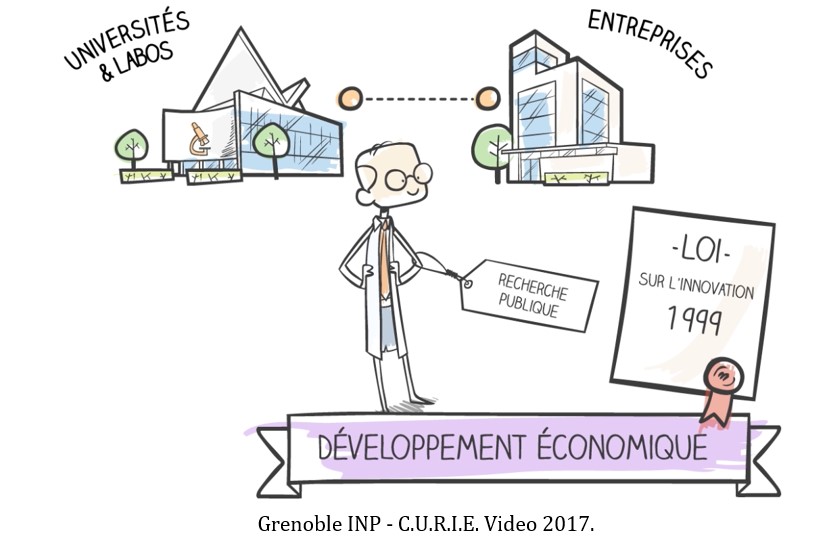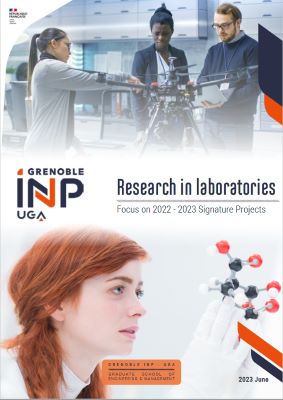
Illustrations in pictures!
Grenoble INP has created an educational video on the first device of the law on innovation coded in the research code in articles (L 531-1 to 5, commonly called 25.1). The video in the form of cartoons, presents in less than 5 minutes, the overall procedure and the steps to be taken before the creation of your company.The video is online on the Grenoble INP YouTube channel:
• 25.1 Law on innovation by Grenoble INP, winner of the C.U.R.I.E. 2017 award

Note: Changes to the 25.1 scheme following the PACTE law:
- Before the PACTE law, the researcher had to devote 100% of his/her time to the company created.
With the PACTE law, the researcher can be full-time or part-time in the company created.
- Before the PACTE law, authorisation was granted for a maximum of 6 years.
With the PACTE law, the authorisation may be granted for a maximum of 15 years (pending confirmation by a forthcoming decree).
- Device 25.1:
- Device 25.2:
► All our resarchers-teachers testimonies in the valorisation area
The law provides for three mechanisms to encourage technology transfert from public research to companies. Recently it has evolved within the framework of the PACTE law (Action Plan for Growth and Transformation of Companies). We will keep you informed of future decrees.
I- The objective of the law
The law on innovation is a French law whose objective is to increase the country’s capacity for innovation and wealth creation thanks to the assets of public research. The benefits are multipartite, with positive spin-offs for- Businesses and territories through technological development and the commercialisation of research results,
- The population through the availability of new products, services, therapies, etc,
- The research laboratories and staff through the visibility of their work and the obtaining of additional financial resources to develop future research,
- The entire institution through the positive impact on its brand image, its reputation for excellence and its notoriety.
II- Its target
The law is aimed at civil servants involved in public research. They are referred to by the generic term “researcher”. This term covers all public research staff, i.e., researchers in the statutory sense, teacher-researchers and engineering and technical staff.The rapprochement between the public and private sectors targeted by the law must be an opportunity for economic development, by ensuring that the interests of the researcher, his employer and the company converge, while lifting the statutory constraints attached to civil servants and guaranteeing a possible return to researchers in their original establishments.
III- How?
To accommodate everyone’s aspirations, the law covers both the creation of start-up and transfer to existing companies. It is divided into three sections allowing public research staff- To participate in the creation of start-up as partners or managers in order to develop their research results protected by Intellectual property (IP): articles L531-1 to 5 of the research code, commonly referred to as 25.1.
- To provide scientific advice to new or existing companies that promote their research results protected by Intellectual property (IP): articles L531-8 to 9 of the research code commonly referred to as 25.2.
- To be a member of the management bodies of a commercial company that valorise research results protected by IP in order to make it aware of the progress of fundamental and applied research and thus enable it to innovate: Articles L531-12 to 13 of the Research Code commonly referred to as 25.3.
The evolution of the law on innovation with the PACTE law allows that at the end of an authorisation granted on the basis of the provisions governing one of the mechanisms provided for in Articles L. 531-1, L. 531-8 and L. 531-12, the civil servant may also benefit from an authorisation granted on the basis of another of these mechanisms. Until now, the official could only move from a 25.1 to a 25.2 or 25.3 or from a 25.2 to a 25.3 and possibly from a 25.3 to a 25.2 if the company valued the researcher's research work.
IV- Details of the different possibilities
- 25.1 (L531-1 à 5)
The conditions for the application of this article are: 1) The company must be new; 2) The researcher is either the manager or a partner. 3) The company created promotes the research results that the researcher has developed during his research activity in his laboratory. The results are therefore protected by Intellectual Proprerty (IP: patent, software, know-how) of which the researcher is the inventor (patent) or author (software, know-how). The IP remains the property of the public institution employing the researcher. The exploitation of the IP by the new company is formalised by the negotiation of a transfer contract between the exploiting company and the researcher’s employing public institution that owns the IP.
Before the PACTE Act, the researcher had to devote 100% of his or her time to the company created. With the PACTE Act, the provisions of Article 25.1 allow the researcher to be immersed in the company created on an incomplete or full-time basis. The researcher can be placed on secondment (only if the agent is full-time) or, depending on his/her status, on secondment or delegation (full or incomplete time) to the company. The company reimburses the researcher’s public employer for the full or incomplete secondment or delegation, which maintains the researcher’s salary. Exceptions to the reimbursement of the employee’s salary by the company are possible. The researcher may receive additional remuneration but, since the PACTE Act, there is a ceiling on this. The ceiling is set by regulation (decree to come). Additional remuneration is paid directly from the company to the employee.
In order to benefit from this provision, the employee must request authorisation from his or her public employer in accordance with the conditions of the general provisions (L531-14) and prior to the negotiation of the transfer contract and before the company is registered in the trade and companies register.- 25.2 (L 531-8 à 9)
The application conditions of this article are 1) the company is existing (newly created or not); 2) it valorises the research results that the researcher has developed during his research activity in his laboratory. Also, as for 25.1, the results are subject to prior IP protection of which the agent is the inventor or author and a transfer contract is signed between the agent’s employer and the company. 3) The researcher provides scientific assistance to the company on his work which is valorised. The scientific assistance takes the form of scientific expertise for the company to support the agent in the work that has been developed and its industrial development.
Under the PACTE Act, the scientific advisor-researcher can spend up to 50% of his or her time in the company (pending confirmation by a forthcoming decree), compared to 20% before the Act. In return for his or her scientific advice, the agent may receive additional remuneration granted by the company to the researcher, which is capped by regulation (decree to come). The additional remuneration is paid directly from the company to the agent.When the scientific consultancy time granted to the company is not compatible with the full-time exercise of the public functions exercised by the employee, the latter is, depending on his status, placed at the disposal of the company or delegated on an incomplete basis. The company reimburses the researcher’s employer, who maintains the researcher’s remuneration, for secondment or delegation. Exceptions to the reimbursement of the employee’s salary by the company.
The employing institution determines the percentage of time granted to the company from which the exercise of scientific consultancy is no longer compatible with the agent’s full-time work in its public institution. Where applicable, a secondment/delegation agreement is drawn up and specifies the duration, the administrative situation of the person concerned, the percentage of time worked by the employee in the company, the conditions for reimbursement of salaries paid by the home establishment and mentions any additional remuneration granted by the company to the researcher.
If there is no secondment, a scientific assistance agreement is put in place and sets out in particular the amount of working time that the person concerned can devote to his or her activity in the company and any additional remuneration with a ceiling.
In addition to the scientific competition, the researcher can also take shares in the capital of the company that valorises his work. Since the PACTE Act, there is no longer a ceiling on the acquisition of capital (before the PACTE Act, this was 49% with a maximum of 49% of voting rights).
To benefit from this provision, the researcher must apply for authorisation from his or her public employer in accordance with the conditions of the general provisions (L531-14).
- 25.3 (L 531-12 à 13)
The application conditions for this article are 1) the company is an existing commercial company (newly created or not) 2) the researcher is a member of the management bodies in order to promote the dissemination of public research results. 3) The company valorises public research results whether or not the researcher is the author or inventor. Therefore, there is no obligation for the company to valorise the Intellectual Property resulting from the researcher or his laboratory of origin: it must develop public research results without any link with the researcher or his employer.
The researcher’s shareholding and voting rights are limited. Under the PACTE Act, researchers can take a maximum 32% stake in the company’s capital (compared to 20% before the Act), giving them a maximum of 32% of the voting rights. The aim of this scheme is to raise companies’ awareness of innovation and to increase companies’ attention to the progress of basic research and its applications. The researcher remains in full time public service.Article L531-13 specifies that researchers may receive additional remuneration through directors’ fees as provided for in Articles L.225-45 and L225-83 of the Commercial Code. The amount of the additional remuneration is capped and set by regulation.
To benefit from this provision, the researcher must apply for authorisation from his or her public employer in accordance with general provisions conditions (L531-14).



